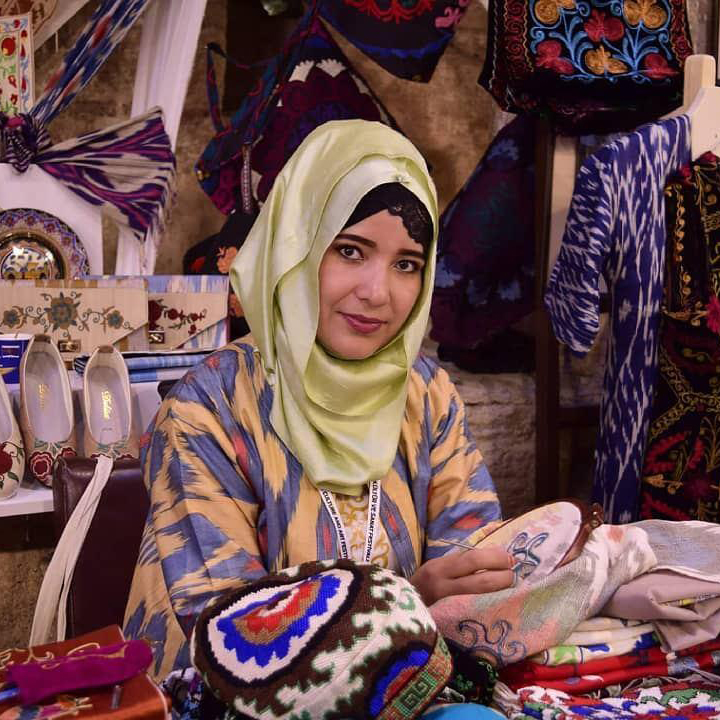Nilyufar Musadzhonova, Embroidery expert: "Centuries may pass, but suzani embroidered by hand never lose their luster."
I was born in 1983 in Tashkent into a working-class family. My mother worked in a kindergarten and my father made shoes, and now both of them are retired. I’m married with three kids, two sons and a daughter.
At school, I went to clubs for knitting and sewing. Once I saw a show on TV in which they talked about our ancestors and their skill for embroidery, and then I really wanted to try embroidery too. But for then it was just a dream. I started attending a Turkish school where I learned Turkish. Then when I was sixteen, a friend of mine invited me to apply for a job at a new workshop that had just opened. I really hoped that knowing Turkish would help me get the job, because there were rumors that the workshop was opened by Turks. It turned out that the owner lived in Turkey, but he himself was from Samarkand.
The word suzani means "needle-sewn," from the Tajik word suzan - “needle.” Suzani are embroidered with silk using different stitches, like kandakhiel (a form of satin stitch), basma (couching stitch), and yurma (chain stitch).
Note:
Note:
The patterns in a suzani are created for a reason, with each one symbolizing something else. Firebirds, for example, represent happiness, and pepper pods are protection from evil spells. Men in suzani are represented by cornflowers, and young girls by poppies.
Over the years, I have had a lot of students, and some of them started their own businesses and became great designers. That makes me very happy.
Unfortunately, these traditions haven’t been preserved everywhere. You can’t find them in Tashkent anymore, for example, but sometimes they can be found in Samarkand, Bukhara, and Shakhrisabz.
I really like that I can balance my work and my household chores. I wake up at seven in the morning, make breakfast, do some work around the house. At ten, my students come and we sit and do our embroidery. I teach them things, we chat, and the girls also say that you don’t notice the time pass when you’re doing embroidery. Then it’s lunchtime, I take a break and then go back to embroidering. Later my husband comes home, we have dinner, and I embroider some more. At home, I’ve made a little corner where no one will bother me.
Before, it was sometimes hard when I didn’t have enough time to do something or I couldn’t do everything myself, and I had to ask others for help. Now I’m able to do everything myself, and if I don’t have time for something I can ask one of my students.
The most valuable thing about our craft is that everything is made by hand - centuries may pass, but the work doesn’t lose its luster. I meet tourists from all over the world, and a lot of people don't believe that my work is handmade. I even had a disagreement with this foreigner, a woman, and I asked her to come back the next day so that I had my tools with me and I could show her my work. The woman came back, and I explained all the elements to her and sewed a couple of them with my crochet. I remember that then she praised my work and said that you couldn’t distinguish it from something made by a machine. That made me very happy. In fact, people who are unfamiliar with the craft are often suspicious, so now, when I go to exhibitions, I always take a tool with me so that people can make sure that everything is handmade.
I took part in exhibitions and festivals in countries around the world - America, Turkey, Oman, Azerbaijan, India and Kazakhstan. And my products have always won prizes, usually first place.
If I embroider every day, it takes me a month and a half to make one suzani. But still, I’ve gotten faster over the years - when I embroidered my first pillowcase, for example, it took me five days, and now I can do that kind of work in three.
My best sales are made at exhibitions and festivals. I also have my own art shop at the Broadway Center. I tried to offer a wide variety of products, because large suzani are quite expensive, and not everyone can afford one, so for the store I embroider small suzani, tapestries, bags and headbands. For smaller items I sometimes use cotton threads instead of silk, to keep the cost down. It’s important to me that people never leave my store empty-handed.
Translation by Dennis Keen


